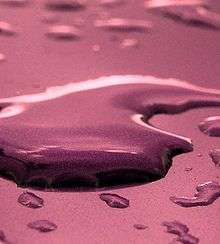Nanotextured surface

A nanotextured surface (NTS) is a surface which is covered with nano-sized structures. Such surfaces have one dimension on the nanoscale, i.e., only the thickness of the surface of an object is between 0.1 and 100 nm. They are currently gaining popularity because of their special applications due to their unique physical properties. Nanotextured surfaces are in various forms like cones, columns, or fibers. These are water, ice, oil, and microorganism repellent that is superamphiphobic, anti-icing, and antifouling respectively and thus self-cleaning. They are simultaneously anti-reflective and transparent, hence they are termed smart surfaces.[1]
In research published online October 21, 2013, in Advanced Materials, of a group of scientists at the U.S. Department of Energy's Brookhaven National Laboratory (BNL), led by BNL physicist and lead author Antonio Checco, proposed that nanotexturing surfaces in the form of cones produces highly water-repellent surfaces. These nano-cone textures are superhydrophobic or super-water-hating.[2][3]
See also
References
- ↑ Nair, Rahul Premachandran (2007). Tribology of Silicon Nano-textured Surfaces Fabricated by Rapid Aluminum-induced Crystallization of Amorphous Silicon. ProQuest. pp. 3–. ISBN 978-0-549-48326-7.
- ↑ DOE/Brookhaven National Laboratory (October 21, 2013). "Nano-cone textures generate extremely 'robust' water-repellent surfaces". ScienceDaily. Retrieved October 22, 2013.
- ↑ Checco, Antonio; Atikur Rahman; Charles T. Black (October 21, 2013). "Robust Superhydrophobicity in Large-Area Nanostructured Surfaces Defined by Block-Copolymer Self Assembly". Advanced Materials. doi:10.1002/adma.201304006.